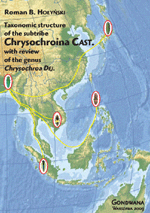
| Strona główna | O firmie | Książki | Kontakt |
| |||||
|
The Chrysochroina CAST. is a large [ca. 400 known species – some 3% of the World buprestid fauna – in 13 genera] subtribe inhabiting almost all tropical and subtropical areas of the Old World. The taxon comprises big or at least medium-sized, often splendidly colourful species, many of which are rather common; moreover, larvae develop in wood of living forest- or orchard-trees including those of considerable economic importance, while size and attractive appearance of adults attract the interest of not only buprestid specialists but also „general nature lovers” and even provoke mass collecting for commercial (jewellery, „souvenirs”) purposes. And none the less they have never been subject of comprehensive phylogenetic or zoogeographic study, and even the last revision (KERREMANS 1908) and catalogue (OBENBERGER 1926) have been despairingly outdated; as the result, taxonomic structure remains poorly understood, available distributional data inexact and frequently erroneous, while knowledge about bionomy and phylogenetic relationships are almost totally lacking. The present book – taxonomic, biogeographic and evolutionary revision of the subtribe at the genus-subgenus level and of its „central” genus, Chrysochroa DEJ. (sensu novo), at that of species and subspecies – is an attempt to fill some of these gaps in our knowledge. The main part [->Contents] is devoted to clarify the relationships between the included taxa: based on the detailed phylogenetic analyses (performed with the newly developed program, MICSEQ; the results shown on 14 trees and detailly described as well for the subtribe as a whole, as for each supraspecific taxon within Chrysochroa DEJ. and for each genus otherwise) a largely refined and emended classification (with keys, full synonymy, morphological descriptions, geographical distribution and taxonomic, nomenclatural, distributional &c. remarks [->example page 135]) is proposed on the one hand, and the ways of evolutionary (with tentative descriptive „reconstructions” of ancestors) and biogeographic (illustrated with „geocladograms” [->example page 91]) development hypothesized on the other. Altogether 64 subgenera in 16 genera of the Chrysochroina CAST., including 137 subspecies in 75 species, 20 circles and 13 subgenera of Chrysochroa DEJ. [1 genus, 14 subgenera, 2 species and 4 subspecies are described as new, while for 3 species and 2 subspecies new names are proposed due to homonymy] are treated, their distribution mapped [->example page 129], and most of them shown on 173 colour photographs [->example tab. 4]. The introductory part (pp. 12-29) discusses the basic approaches, assumptions and conventions accepted in the book, while the concluding chapters (pp. 311-330) evaluate to what degree these approaches and conventions proved correct and appropriate, and what general taxonomic, biogeographic and evolutionary conclusions can be drawn from the results presented in the systematic part (some new or disputable methods, concepts and hypotheses are critically commented upon [->example page 314]). List of quoted literature includes 386 publications. Podplemię Chrysochroina CAST. to duża [ok. 400 znanych gatunków – ok. 3 % światowej fauny rodziny bogatkowatych (Buprestidae)] grupa zasiedlająca niemal wszystkie tropikalne i subtropikalne obszary Afryki, Azji, Australii i Oceanii. Te duże lub co najmniej średniej wielkości, zwykle efektownie ubarwione chrząszcze są popularne nie tylko wśród specjalistów ale także wśród nieprofesjonalnych kolekcjonerów i miłośników przyrody, a także bywają masowo zbierane w celach komercyjnych (biżuteria, pamiątki); co więcej, wiele z nich występuje dość pospolicie, a ich larwy rozwijają się w drewnie żywych drzew leśnych lub sadowniczych o nierzadko dużym znaczeniu gospodarczym. A jednak relacje filogenetyczne i biogeograficzne tej grupy nigdy nie były analizowane, a nawet ostatnia rewizja taksonomiczna (z roku 1908) jest już beznadziejnie przestarzała. Prezentowana tu książka – taksonomiczna, biogeograficzna i filogenetyczna rewizja tego podplemienia na poziomie rodzajów/podrodzajów, a „flagowego” rodzaju Chrysochroa DEJ. na poziomie gatunków/podgatunków – jest próbą zapełnienia tej luki. Część systematyczna [->Contents] jest poświęcona wyjaśnieniu taksonomicznych (klucze do oznaczania, pełna synonimika, opisy morfologiczne ->przykładowa strona 135), biogeograficznych (mapki rozmieszczenia ->przykładowa strona 129) i ewolucyjnych (drzewa ewolucyjne, geokladogramy ->przykładowa strona 91) relacji w ramach podplemienia; omówione zostało 16 rodzajów z 64 podrodzajami, w tym 13 podrodzajów z 75 gatunkami obejmującymi 137 podgatunków rodzaju Chrysochroa DEJ. [1 rodzaj, 14 podrodzajów, 2 gatunki i 4 podgatunki opisane zostały jako nowe dla nauki, wprowadzono też niezbędne nazwy zastępcze dla 3 gatunków i dwu podgatunków]. Opisy uzupełniają 173 barwne fotografie [->przykładowa tab. 4]. Poza tym we wstępnych rozdziałach przedstawiono główne założenia, metody i konwencje przyjęte w opracowaniu, a w rozdziałach końcowych ocenę na ile te założenia i metody sprawdziły się w praktyce i jakie ogólne wnioski teoretyczne (taksonomiczne, biogeograficzne i ewolucyjne) można wyciągnąć na podstawie wyników pracy (z krytycznym omówieniem niektórych nowych lub dyskusyjnych koncepcji i hipotez ->przykładowa strona 314). |
|||||
| Copyright by GONDWANA |
